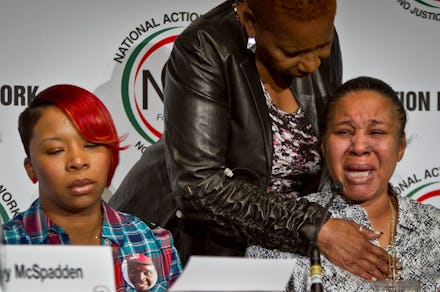In One Quote, Eric Garner's Widow Nails Why Body Cameras Aren't the Solution

"He was actually dying, OK? Screaming he could not breathe, OK? And you see it on camera — and still. So all that video-camera nonsense? That's exactly what is."
These were the words of Esaw Garner, the widow of Eric Garner — the 43-year-old black man who died last July after a Staten Island, New York, police officer placed him in a chokehold — during a Wednesday night panel discussion at Al Sharpton's National Action Network conference. The conference took place in the wake of a police shooting in South Carolina in which a white police officer shot and killed 50-year-old Walter Scott in the back as he ran away.
The officer, Michael T. Slager, initially claimed that he killed Scott in an act of self-defense. But after a bystander handed over video footage of the incident, it became clear that Slager's story was off. Scott was running from Slager, not fighting him, and Slager aimed his gun and fired eight shots into his back anyway.
Without video evidence, it's likely the false narrative crafted by Slager and bolstered by "police and witnesses" would have remained. But as Esaw Garner argued, video evidence isn't always enough to ensure justice — her husband's killer was let off scot-free, despite video evidence that clearly implicated him.
During the event, Garner was flanked by family members of other victims of police brutality: William Bell, father of Sean Bell, John Crawford Jr., father of John Crawford III, Samaria Rice, mother of Tamir Rice, Lesley McSpadden, mother of Michael Brown. Garner shook her head when a journalist posited that video footage could help bring justice.
Having documented footage is certainly not a bad thing. As the case of Walter Scott shows, it can go a long way in cases of police brutality — Slager, after all, was charged with murder following the release of the video.
Moreover, video evidence has been instrumental in bringing the issue of police brutality to the forefront of the national conversation. Clear, indisputable visual proof that wrongdoing occurred is almost always more powerful than words alone, and although it's horrific to watch, sometimes that's what it takes. As Zak Cheney-Rice wrote, "In the end, it brings us closer to the truth of the violence this country has been committing against black people for generations."
But Esaw Garner is ultimately right: It's not enough, at least not by itself.
Video evidence, whether captured by a bystander or collected from the police themselves using body cameras, won't solve the problem of police brutality. It's an infinitely more complex problem, rooted in racial dynamics, social hierarchies, institutional rot and systems of power. They're supremely difficult issues to acknowledge, let alone fix.
"My son was shot 50 times," William Bell told the audience on Wednesday night. "You think about that, no camera in the world would have changed that, you know why? Because what are they going to do: 'The street was dark.'"
We won't stop police brutality by filming it, and any expectation to the contrary is a willful denial of the root of the problem. It's a start, not a solution.